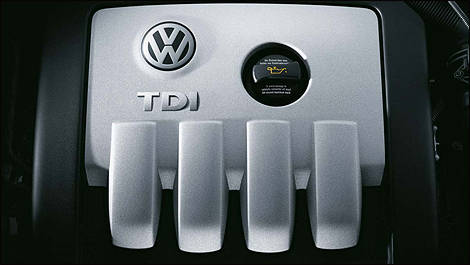The arrival of “TDI” engines allowed diesel car engines to turn out performances comparable to those of equal-sized gas engines while reducing such inconveniences as noise, soot and pollution generally associated with diesel engines.
When the diesel engine was first developed, it directly injected fuel into the combustion chamber. Very simple, the massive injection of fuel into a combustion chamber filled with very hot air and at high temperature results in rapid combustion and the equally rapid increase of the pressure in the chamber. This phenomenon is at the root of the classic diesel clatter.
In addition, the massive injection pushes a part of the ignited fuel against the relatively cold walls of the cylinder. Combustion stops on contact and the partially burned fuel particles become soot.
At the end of the 1970s, European automakers introduced diesel engines that used a primary antechamber to mechanically inject the fuel and start the combustion. A passage allowed the ignited fuel to reach the main combustion chamber.
By injecting the fuel into the smaller antechamber the noise associated with the violent increase in pressure is considerably reduced. In addition, as the antechamber is smaller its walls warm up faster, which in turn reduces the production of soot. However, these direct injection engines are less fuel-efficient.
Thanks to modern electronics and information technology, the quantity of fuel injected is now controlled by an electro-mechanical or piezo-electric valve that can perform several injections per stroke. Thus, in a TDI engine a first small injection starts the combustion, warms up the walls of the combustion chamber and increases the pressure. A second, larger injection produces the power, and a last injection reduces the amount of soot particles by incinerating them.
These multiple injections limit the noise and soot produced by the direct injection system while increasing its effectiveness.
With the addition of a turbocharger, which uses the residual energy of exhaust gasses that would otherwise be lost to introduce more air into the combustion chamber, the engine’s efficiency is further increased. The extra air enables the injection of more fuel, which increases the engine’s output. In this way, a TDI engine offers power comparable to that of a gasoline engine of the same size.
photo:Volkswagen
When the diesel engine was first developed, it directly injected fuel into the combustion chamber. Very simple, the massive injection of fuel into a combustion chamber filled with very hot air and at high temperature results in rapid combustion and the equally rapid increase of the pressure in the chamber. This phenomenon is at the root of the classic diesel clatter.
In addition, the massive injection pushes a part of the ignited fuel against the relatively cold walls of the cylinder. Combustion stops on contact and the partially burned fuel particles become soot.
 |
At the end of the 1970s, European automakers introduced diesel engines that used a primary antechamber to mechanically inject the fuel and start the combustion. A passage allowed the ignited fuel to reach the main combustion chamber.
By injecting the fuel into the smaller antechamber the noise associated with the violent increase in pressure is considerably reduced. In addition, as the antechamber is smaller its walls warm up faster, which in turn reduces the production of soot. However, these direct injection engines are less fuel-efficient.
Thanks to modern electronics and information technology, the quantity of fuel injected is now controlled by an electro-mechanical or piezo-electric valve that can perform several injections per stroke. Thus, in a TDI engine a first small injection starts the combustion, warms up the walls of the combustion chamber and increases the pressure. A second, larger injection produces the power, and a last injection reduces the amount of soot particles by incinerating them.
These multiple injections limit the noise and soot produced by the direct injection system while increasing its effectiveness.
With the addition of a turbocharger, which uses the residual energy of exhaust gasses that would otherwise be lost to introduce more air into the combustion chamber, the engine’s efficiency is further increased. The extra air enables the injection of more fuel, which increases the engine’s output. In this way, a TDI engine offers power comparable to that of a gasoline engine of the same size.
photo:Volkswagen


